AVADirect Clevo P170EM Part 2: GTX 680M Grudge Match
by Jarred Walton on October 15, 2012 6:50 PM ESTClevo P170EM GTX 680M Gaming Performance
We don’t have any major qualifications to go over before we hit the GTX 680M benchmarks, but we did end up running our gaming suite multiple times. The initial shipping driver was a 295 Series NVIDIA build, which is now getting somewhat old. We tested our core gaming suite with those drivers before updating to the 306.23 drivers, and then more recently the 306.97 drivers (there was almost no change in performance between the .23 and .96 drivers, if you’re wondering). Unlike AMD’s Hotfix driver, NVIDIA’s 306.xx driver update is more of a mixed bag—a few games improve in performance, but several titles in our test suite actually drop a bit. Of course, the GTX 680M already had a commanding lead, so losing a few FPS isn’t likely to hurt too much. Here’s the list of notebooks we’ve lined up for the graphs this time (and note that all of the laptop names link to the specific reviews):
| Notebook Configuration Overview | ||||
| Laptop | CPU | Graphics | Storage | Battery |
| AlienwareM17x R4 | Intel i7-3720QM | GTX680M/HD4000 | Hybrid (Intel SRT) | 90Wh |
| AlienwareM18x R2 | Intel i7-3820QM | GTX680M-SLI/HD4000 | SSD RAID | 97Wh |
| ASUS G74SX-A2 | Intel i7-2630QM | GTX560M/HD3000 | SSD | 90Wh |
| Clevo P170EM GTX 680M | Intel i7-3720QM | GTX680M/HD4000 | SSD | 77Wh |
| Clevo P170EM HD 7970M | Intel i7-3720QM | HD7970M/HD4000 | SSD | 77Wh |
| iBUYPOWERCZ-17(MSI GT70) | Intel i7-3610QM | GTX675M/HD4000 | SSD | 60Wh |
| Razer Blade 2012 | Intel i7-3632QM | GTX660M/HD4000 | Hybrid (Intel SRT) | 60Wh |
| Samsung Series 7 | Intel i7-3615QM | GT650M/HD4000 | Hybrid (ExpressCache) | 77Wh |
This is a grudge match between AMD and NVIDIA, and now that we’re sporting the same hardware the only thing separating us from the mobile gaming performance crown is a few pages of benchmarks. We’re going to skip straight to the stuff that presumably everyone is here to see: gaming performance. If you want to see how the P170EM GTX 680M stacks up against the HD 7970M in general applications, we reran all of our general application tests and basically came up with a tie, so we’re going to skip those this time around (though they’re available in Mobile Bench).
Mainstream 1600x900 Gaming
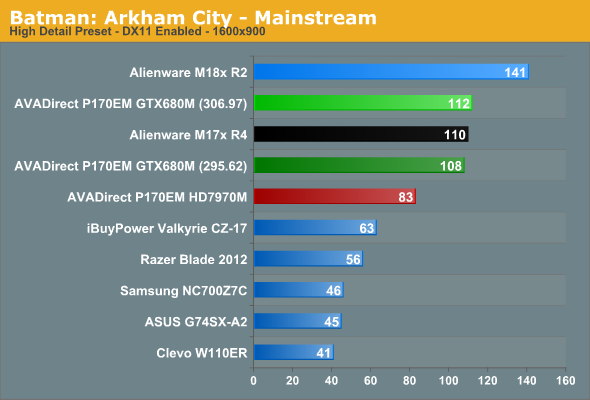
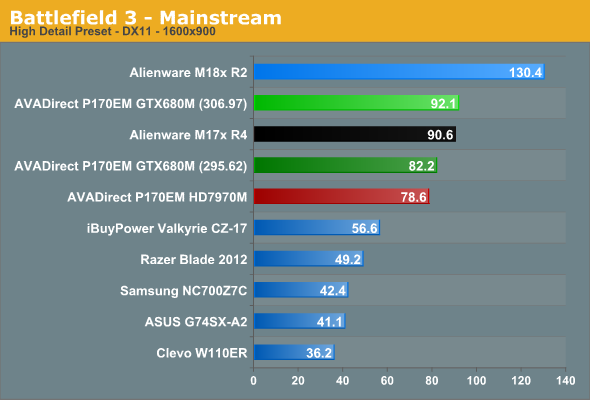
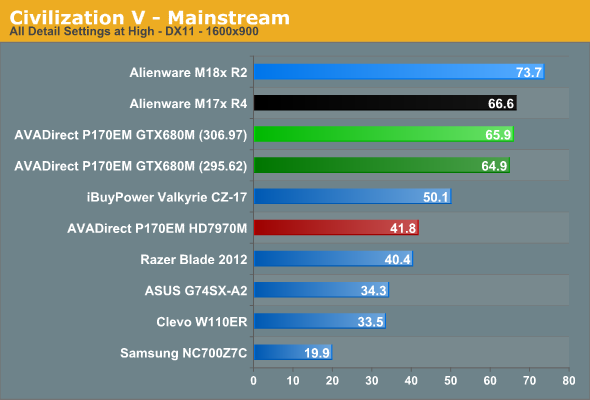
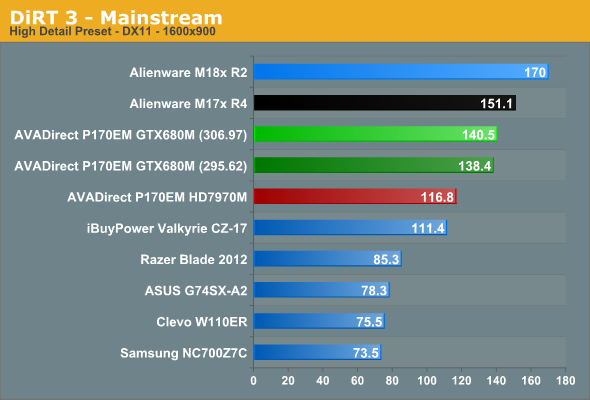

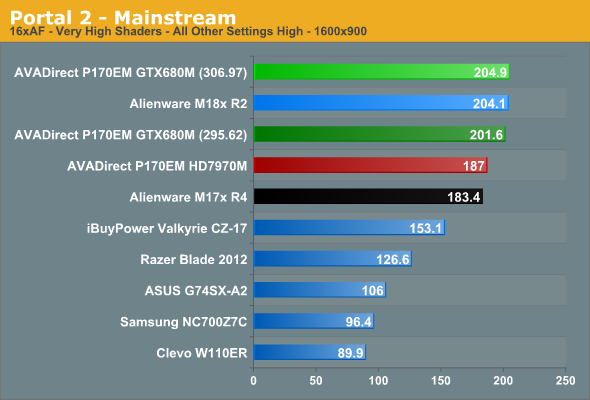
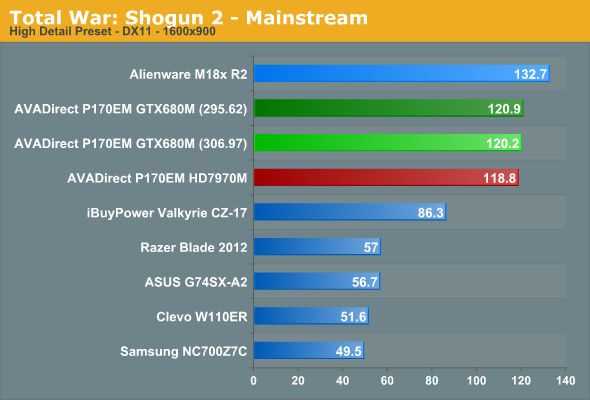
Right out of the gates, NVIDIA’s GTX 680M takes a commanding lead in our Mainstream testing (1600x900 with ~High details). The margin of victory is as much as 58% (Civilization V), though we do have a couple of games that are basically tied (Skyrim goes to the HD 7970M by a couple percent while Shogun 2 favors GTX 680M by just over 1%). With our less demanding settings, NVIDIA leads by an average of 15%—right about what you would want from an 11-15% increase in overall notebook cost. But then, it’s unlikely anyone would plunk down roughly two grand (give or take) just to run at moderately high settings and 1600x900; let’s see what happens when we turn the settings dial to 11.
Enthusiast 1920x1080 Gaming
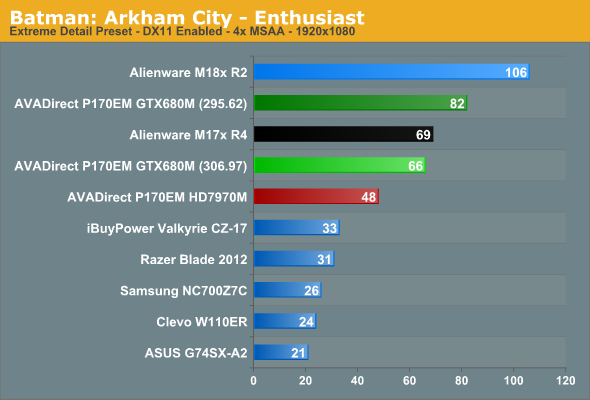
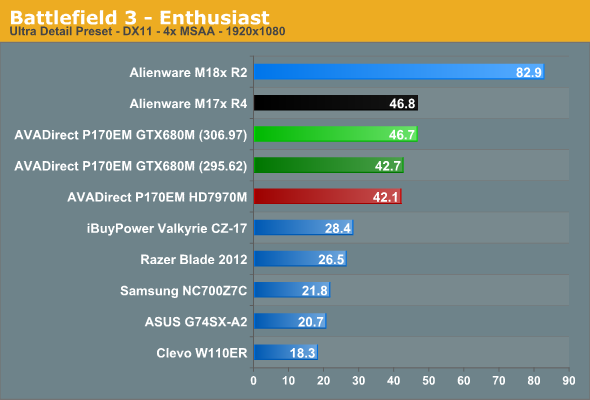
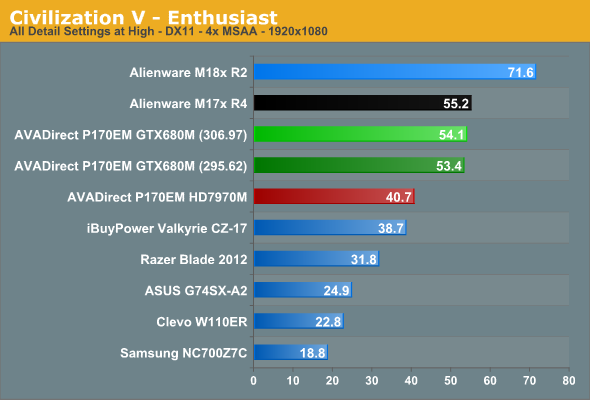
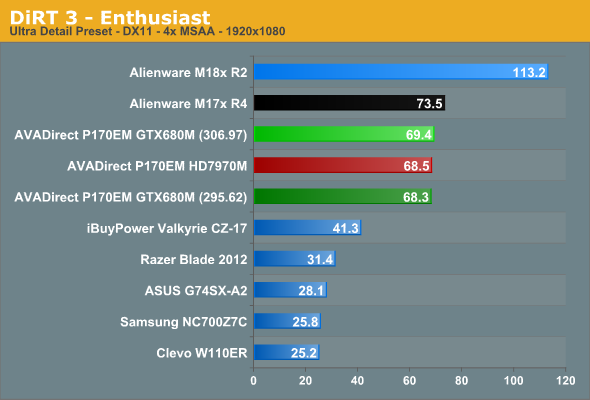
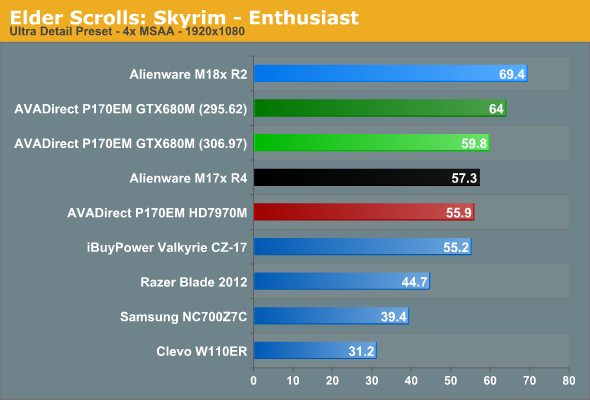
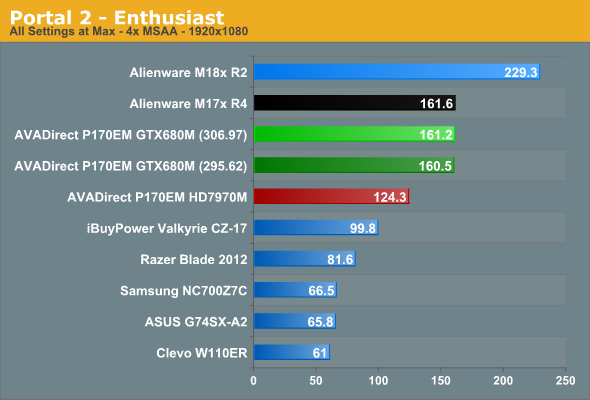

The gap at our Mainstream settings was moderately close, but at Enthusiast detail we end up with several serious blowouts, and unfortunately there’s not a single bright spot for AMD. Batman is a 38% lead for NVIDIA, Civilization V is 33%, and Portal 2 is 30%; those are balanced by a tie in DiRT 3, a scant 7% lead in Skyrim, and an 11% lead in Battlefield 3. Incidentally, Alienware’s M17x R4 shows generally similar performance, with some variations likely caused by differences in the drivers and other components.
As for Shogun 2, unfortunately there’s a driver bug of sorts that prevents us from even testing out the “Very High” preset with AMD’s 7970M—basically, the game looks at the capabilities of the Intel HD 4000 iGPU, which doesn’t allow a few key selections, even though the game is actually supposed to be looking at the HD 7970M. We did run 1080p with identical “nearly max” settings on both GPUs, however, and at least at those settings we wind up with a blowout for NVIDIA: 46.2 FPS compared to 31.3 FPS.
NVIDIA basically takes a clean sweep of our regular gaming benchmarks, but we’re not done with the gaming discussion just yet. We decided to look at some other more recent releases to try to better characterize gaming performance.










58 Comments
View All Comments
JarredWalton - Tuesday, October 16, 2012 - link
It should be possible, but buying a GTX 680M module on its own can cost $900 or something insane. If anyone has a good link to where you can find just a GPU upgrade for the P170EM, please post. Best I can find right now is on eBay:http://www.ebay.com/itm/CLEVO-X7200-UPGRADE-KIT-NV...
Needless to say, waiting for the Hotfix at this point is reasonable. Barring that, I'd suggest selling your existing system and buying one with GTX 680M rather than just paying for the GPU upgrade.
Wixman666 - Tuesday, October 16, 2012 - link
Don't worry about it.. the difference isn't large enough to upgrade the video or take a bath on selling then buying the other unit.TrantaLocked - Tuesday, October 16, 2012 - link
Great review Jarred!Jamahl - Tuesday, October 16, 2012 - link
Fact is this is a very Nvidia-friendly gaming suite - that's why this site consistently scores as an outlier for Nvidia. As a rule of thumb you want to subtract 10% from the overall result to find the true position of the Nvidia card - true as in what the majority of the tech press find.Even then this particular review is pretty horrible on the 7970, as it has had the best performing games removed (Crysis and Metro). Quite why those are worth removing instead of the complete Nvidia outlier Portal 2 is a mystery (I'm sure we all have our suspicions), but there you go.
JarredWalton - Tuesday, October 16, 2012 - link
You include Crysis and Metro and then suggest our gaming suite needs updating? Give me a break. We removed Crysis as a test game for laptops about two years ago... when Warhead was "only" two years old already. When we revise the gaming suite next time, I'm pretty sure we'll drop Civ5, TWS2, and some of the other games. DiRT 3 was originally an AMD game, but NVIDIA has long since caught up. Civ5 was also an AMD game. Total War: Shogun 2 is an AMD title as well. You see the problem with your assertion that we're "NVIDIA-friendly" yet? So here's the full rundown of the fifteen tested games:Batman: NVIDIA
Battlefield 3: NVIDIA
Borderlands 2: NVIDIA
Civilization V: AMD
Diablo 3: Agnostic
DiRT 3: AMD
DiRT Showdown: AMD
Elder Scrolls Skyrim: Agnostic
Guild Wars 2: Agnostic
Max Payne 3: NVIDIA
Portal 2: Agnostic
Sleeping Dogs: AMD
Sniper Elite V2: AMD
Total War Shogun 2: AMD
Witcher 2: NVIDIA
Final tally:
AMD Titles: Six
NVIDIA Titles: Five
Neutral Titles: Four
The problem you're having is that NVIDIA has generally spent more time and effort optimizing for games, which means that some of the neutral and AMD-sponsored games are now running better on NVIDIA hardware than on AMD. Or maybe you think it's unfair that when we sort alphabetically, NVIDIA titles happen to occupy the first three slots and AMD has three of the last four? Going back to run games that few people are still playing just to try to make things "fair" is actually being the exact opposite. Crysis and Metro? Please. Why not Crysis 2 at least -- oh wait, it's an NVIDIA title.
Brainling - Tuesday, October 16, 2012 - link
Crysis and Metro? Seriously? It's almost 2013, we're four full game cycles away from the release of Metro, and much farther from Crysis.For that matter, my 670 barely breaks a sweat on Metro at 1200p max everything , why would you test a 680 with it? Is it a yawning test to see how bored the graphics card can seem?
silverblue - Friday, October 19, 2012 - link
I don't think it's NVIDIA's fault as a whole that they offer better support than AMD. It's also worth showing games like Portal 2 and DiRT Showdown which have very high framerates because it's interesting to find out why one architecture might monster through them (6xx series) where another might not (7xxx series).I've never actually played Crysis, but from the benchmarks, it looks amazingly inefficient and not a complete representation of what a graphics card can and cannot do.
I used to defend AMD's drivers quite vehemently; after all, they'd never caused me any issues. However, when I see issues with Enduro, poor and non-existent Hybrid Crossfire scaling, GPU underutilisation, slack support for driver command lists, poor video encoding quality... need I go on? AMD could make the best hardware around (and, in reality, it probably does), but what would really benefit them is shifting resources to the software development side. If they're going to be powering two of the next consoles, it's in their best interests to get software support up to scratch. Hardware is all well and good but if the software support isn't completely there...
BiggieShady - Tuesday, October 16, 2012 - link
On the last page, instead of "I’ve beat that horse enough" there should be "I’ve beaten that horse enough". To Beat is an irregular verb - beat, beat, beaten. You should use past participle here - beaten. Or just stop beating the poor horse :)Tijgert - Tuesday, October 16, 2012 - link
For starters the GPU IS upgradeable (see eBay) and over time, with the release of newer GPU's, it will make financial sense to do so. Right now if you can get a great deal on a system with a 7970m you still get the second best performing card in the world with a future upgradeability guarantee (MXM is a standard, not proprietary tech).I think the reasoning of a relative graphics performance increase equal to the total price increase being reasonable or financial sound is something only a teenager or rich madman would swallow.
Given that all the other bits don't increase equally you end up paying a lot for a little.
The screen resolution stays the same, the battery lasts just as long, the CPU doesn't tick any faster, the amount of memory doesn't increase and the Gigs on your SSD don't increase either.
As long as you can get great visuals (even if not at 4xAA and enough detail to see textured zits) at a very playable framerate, you're doing just fine. Just enjoy it and wait for that 690m or 700m or whatever MXM 3.0b card to come out that's better and just upgrade.
FYI I'm on the fence on getting a completely tricked out 2200 euro (yes, euro) system that's three months old for 1560 with a 7970m... or saving for a 680m... see, I'm actually a graphics whore too even if may sound sensible at times...
JarredWalton - Wednesday, October 17, 2012 - link
If a notebook supports the newer GPU with its BIOS/firmware, you can upgrade to a newer GPU. However, just because MXM is a standard doesn't mean all MXM GPUs will work. Take for example the last-generation Clevo notebooks; I'm pretty sure the P150/170HM received the necessary BIOS update to work with 7970M/680M. However, the generation before that AFAIK can't run 7970M/680M. The cards will fit but they don't work properly. As I note below, you can't buy a P1x0EM without a GPU, though, so there's not a real need to compare pricing of just the GPUs. I'm reviewing the P170EM and looking at 7970M vs. 680M, not talking about "should you try to upgrade your older notebook with a 7970M or a 680M?"For your 7970M setup, wait for a week and then maybe we'll know if you should trust AMD's updated drivers.